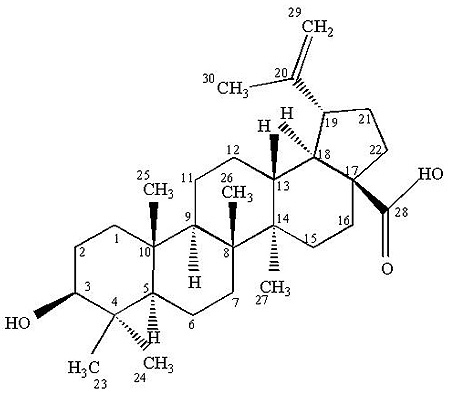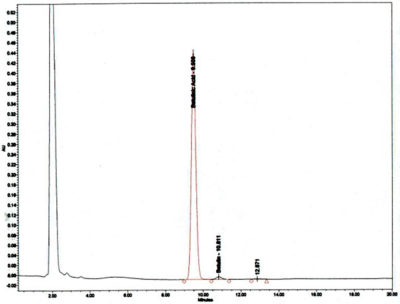A pentacyclic triterpenoid isolated from the bark of Betula alba (the white birch tree), which is active against melanoma cancer, HIV, malaria, herpesvirus and leishmaniasis
- Catalog No: APH-02012
- CAS Number: 472-15-1
- Chemical Formula: C30H48O3
- Molecular Weight: 456.71
- Purity: > 98.5 % determined by HPLC
- Appearance: White to off-white crystalline solid
- Solubility: Poorly soluble; soluble in DMSO (50 mM)
- Stability: Solids stored at 5ºC should be stable up to 1 year. Stock solutions stored at -20ºC should be discarded after 1 month unless retesting confirms product quality.
- Storage: 5ºC
- Shipping: Ambient
- Handling: Nominal
Source:
Betulinic acid and its precursor, betulin are components of the bark of the Betula alba (white birch) tree. The tree is fast-growing and abundant in North America and Europe. The raw material is readily available in large quantities since birch bark is considered a waste product in the pulp and paper, and furniture manufacturing industries.
Aphios manufactures betulinic acid and betulin from white birch bark) utilizing its patented SuperFluids™ CXP technology. Betulinic acid is then purified using chromatography techniques.
Betulinic acid can be manufactured from betulin in a 2-step semi-synthetic process with an overall yield of approximately 71%.
Biological Activity:
Betulinic acid has demonstrated cytotoxic activity specific for melanoma cells both in vitro and in vivo.
In vitro, this melanoma-specific cytotoxicity occurs through apoptosis; however, this mechanism is not well understood. When administered intraperitoneally to athymic mice bearing human melanoma xenografts, betulinic acid is concentrated in the tumors, resulting in rapid tumor regression with no observable toxicity to the animal even at high doses (e.g., 500 mg/Kg body weight, i.p.). Direct injection of betulinic acid into the tumor of xenografts induced apoptosis within the tumors (Pezzuto et al., 1999).
Betulinic acid has been shown to have potent anti-HIV activity with an EC50 of 1.4 µM and a therapeutic index of 9.3 (Lee et al., 1997) by a novel mechanism of action. It prevents entry of HIV into the target cell, but it may also act at the maturation stage.
Betulinic acid and its derivatives have also demonstrated anti-infective bioactivity activity against herpesvirus (Carlson et al., 1998), malaria (Bringmann et al., 1997) and leishmaniasis (Chowdhury et al., 1997).
Biological Activity:
Betulinic acid has demonstrated cytotoxic activity specific for melanoma cells both in vitro and in vivo.
In vitro, this melanoma-specific cytotoxicity occurs through apoptosis; however, this mechanism is not well understood. When administered intraperitoneally to athymic mice bearing human melanoma xenografts, betulinic acid is concentrated in the tumors, resulting in rapid tumor regression with no observable toxicity to the animal even at high doses (e.g., 500 mg/Kg body weight, i.p.). Direct injection of betulinic acid into the tumor of xenografts induced apoptosis within the tumors (Pezzuto et al., 1999).
Betulinic acid has been shown to have potent anti-HIV activity with an EC50 of 1.4 µM and a therapeutic index of 9.3 (Lee et al., 1997) by a novel mechanism of action. It prevents entry of HIV into the target cell, but it may also act at the maturation stage.
Betulinic acid and its derivatives have also demonstrated anti-infective bioactivity activity against herpesvirus (Carlson et al., 1998), malaria (Bringmann et al., 1997) and leishmaniasis (Chowdhury et al., 1997).

